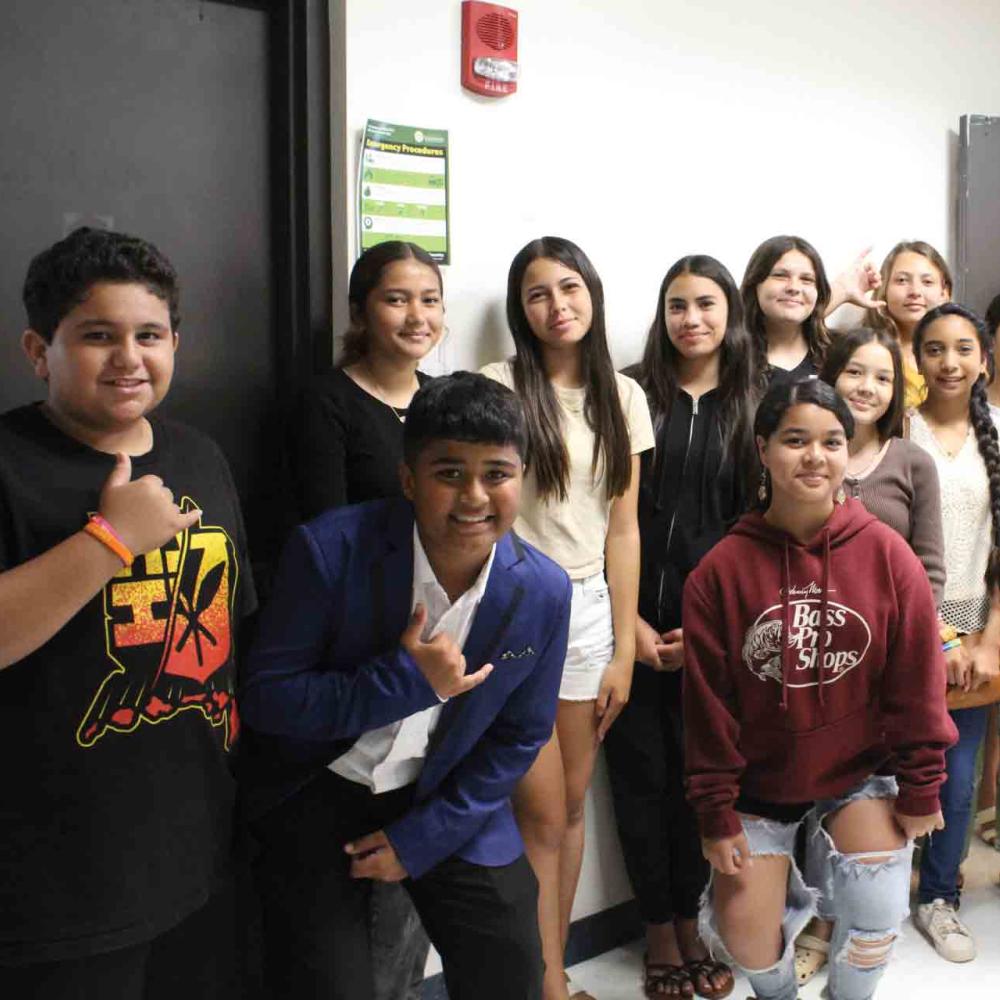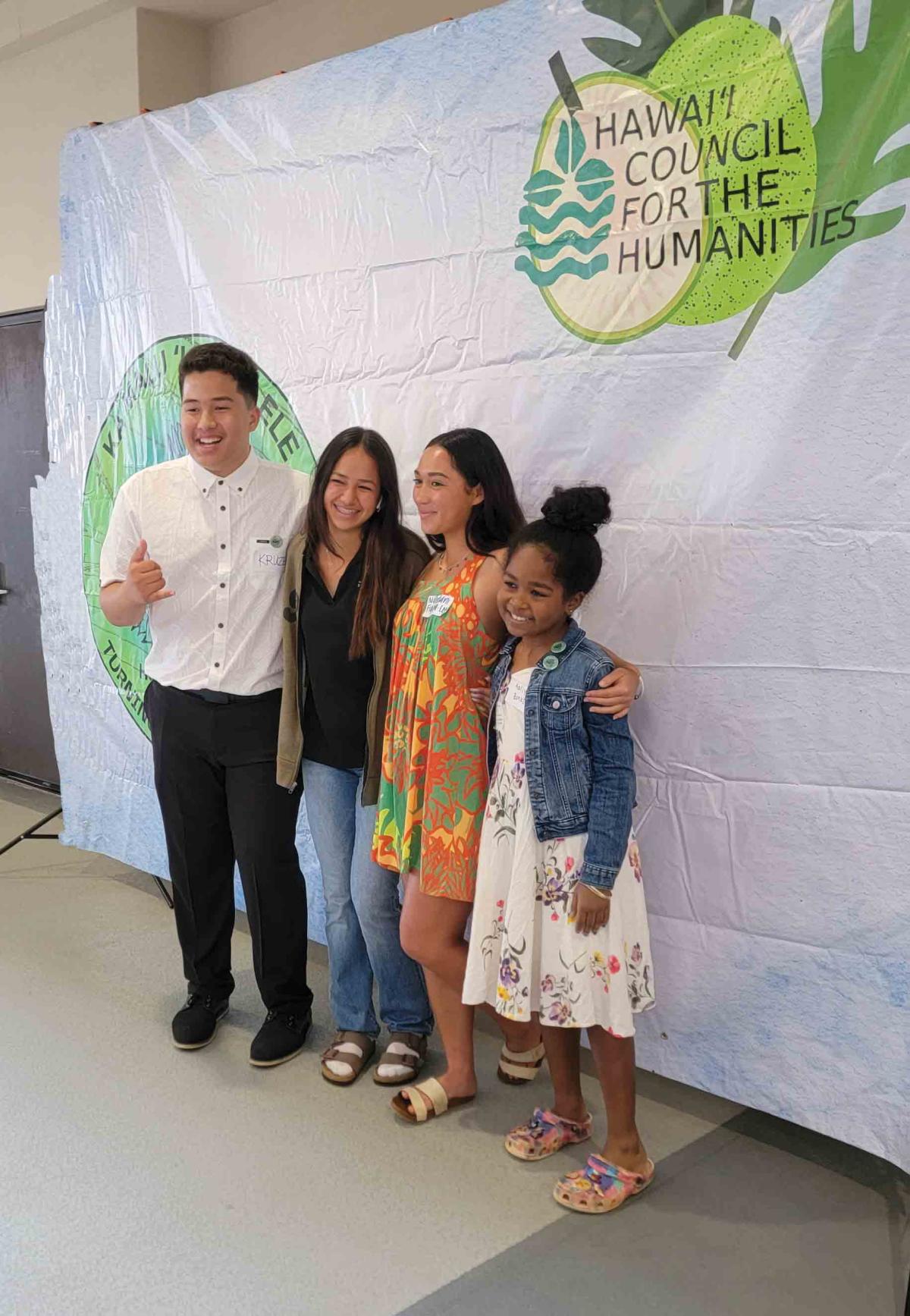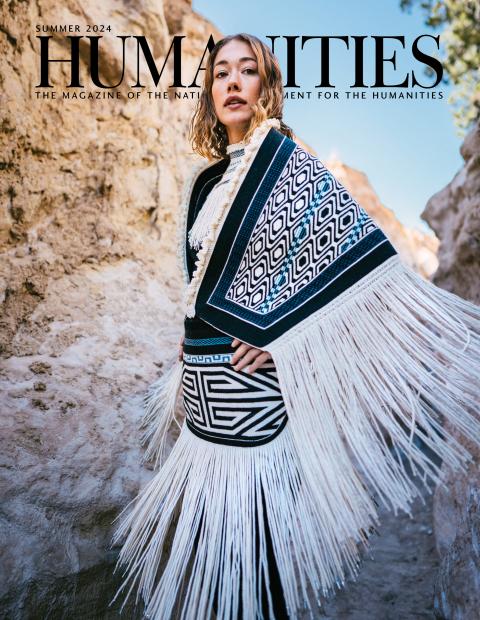On a bright April day, a crowd of several hundred souls gathered at Windward Community College for Hawaiʻi History Day. Located in Kāneʻohe on the island of Oʻahu, the normally serene campus, nestled in the verdant foothills of the majestic Koʻolau Mountains, was abuzz with excited voices.
In all, 311 students representing 34 schools, along with their teachers, parents, and dozens of volunteer judges, participated in the annual event sponsored by the Hawaiʻi Council for the Humanities. “We have been running a state affiliate of National History Day for 35 years,” noted Executive Director Aiko Yamashiro.
Each year, Hawaiʻi Council for the Humanities chaperones a delegation of 50 to 60 students to the national competition at the University of Maryland, near Washington, D.C.
“Participating in the National History Day competition is a transformative experience for our young people,” said Yamashiro. “In addition to the competitions, students visit national museums, meet our congressional delegates at the Capitol, and share our ʻōlelo Hawaiʻi (Hawaiian language) projects with an international audience.”
This year, Hawaiʻi History Day was coordinated by Devin Makizuru and attended by two representatives from the National Endowment for the Humanities: Senior Deputy Chair Anthony Mitchell and Strategic Advisor for Native and Indigenous Affairs Jason Packineau.
“To do well in Hawaiʻi History Day, students have to analyze their sources—who is saying this and why? They have to think about the many things that lead to a decision or action and the many consequences. They learn that nothing is black or white in history—or in the present or the future,” Yamashiro said.
“Young people want to make the world a better place and are not afraid to take a hard look at history to do that.”
One aspect of Hawaiʻi History Day that distinguishes it from similar events across the country is its ʻōlelo Hawaiʻi program, which began in 2019, thanks to a push from the students and teachers of Ka ʻUmeke Kāʻeo, a Hawaiian-language immersion public charter school located in Keaukaha on the island of Hawaiʻi.
Yamashiro shared that when Ka ʻUmeke Kāʻeo students submitted their Hawaiʻi History Day projects entirely in the Hawaiian language five years ago, organizers had a decision to make—ask the students to provide translations of their projects or find judges fluent in Hawaiian.
They chose the latter.
Since then, the ʻōlelo Hawaiʻi program has grown significantly, with 51 students from five schools participating this year. Bruce Torres Fischer has been involved with Hawaiʻi History Day as a volunteer judge in the ʻōlelo Hawaiʻi category since the program’s inception. Last year he assumed the role of historian consultant, helping to coordinate judging for ʻōlelo Hawaiʻi projects.
“It’s been inspiring to see the growth of the ʻōlelo Hawaiʻi category,” Torres Fischer said. “Hawaiʻi is the only participant in the National History Day competition that is representing an endangered Indigenous language through student projects, and I believe that is something very special for the world to witness and for our haumāna (students) to experience.”
The top two winners in both the junior and senior divisions of the ʻōlelo Hawaiʻi competition will have their travel to the national competition sponsored. One of these students is Māhealani Figueroa-Lee, a junior from Ka ʻUmeke Kāʻeo, who took second place in the senior division with her documentary Nā Radiō o Hawaiʻi: He Huliau (Radio Stations of Hawaiʻi: A Turning Point).
Figueroa-Lee’s project focused on the establishment and evolution of Native Hawaiian radio stations in twentieth-century Hawaiʻi, highlighting three specific stations and their respective roles in providing a catalyst for preservation and revival of Hawaiian language, music, and culture in a time when it was illegal to teach the Hawaiian language in schools, and Native Hawaiians were compelled to assimilate into Western society.
The first such radio station, KHBC, was founded in 1936 and broadcast from Keaukaha on Hawaiʻi Island, where Figueroa-Lee’s school is located. Radio station KHBC was immortalized in a well-known song, “KHBC,” by celebrated Native Hawaiian songwriter Vickie Iʻi Rodrigues.
While helping her kumu (teacher), Kaimana Kawaha, research radio station KHBC for his presentation at the International Conference on Indigenous Language Documentation, Education, and Revitalization in Indiana last October, Figueroa-Lee saw the potential to expand the study into a project for Hawai’i History Day.
Original source documents for Figueroa-Lee’s project came primarily from Hawaiian-language newspapers, scanned copies of which are housed on the Papakilo Database, a resource of the Office of Hawaiian Affairs.
Despite the 1896 ban on teaching the Hawaiian language following the overthrow of the Hawaiian Kingdom in 1893, Hawaiian-language newspapers continued to thrive for decades, with the last published in 1948. “Ultimately, I’m just so grateful that all those [articles] were written and kept. It also made me realize that KHBC must [have been] very important for our community,” Figueroa-Lee said. “Considering the time and the state of the Hawaiian language, I realized that this must have been a tool that our kūpuna (elders) were using to preserve our language; a place where we can tune in and listen and hear our own people talking and hear native speakers and our songs.”
Figueroa-Lee compared the kūpuna’s use of technology in the 1930s to preserve Hawaiian language and culture to efforts currently being made by Native Hawaiian and other Indigenous content creators on social media. “I think it’s a really interesting way to bring out our kūpuna’s perspective and their acts of kūʻē (resistance).”
Kapela Wong, a Hawaiian-language lecturer at Windward Community College, was a judge in the ʻōlelo Hawaiʻi portion of the event. Wong said that in addition to looking at the students’ references and use of primary sources, “I looked at how the student presented their researched information using relevant ‘ōlelo noʻeau (proverbs), mele (songs), and idioms. When students were able to do that it was really impressive. There were several mīkololohua (eloquent) moments that left a smile on my face.”
One of Figueroa-Lee’s teachers at Ka ʻUmeke Kāʻeo, Māhealani Lono, has worked with her since she was in the fourth grade. “I’m proud to know somebody who, at this age, can discipline and motivate herself to create pieces like she does every year,” Lono said. “History Day projects provide an avenue for students to demonstrate aloha naʻauao (love for learning) as they steer their course and depth of research,” Lono continued. “It’s also a venue to highlight local histories that tie to community, families, and ancestors.”
“I believe that knowing your history and where you come from is how you achieve your identity,” said Figueroa-Lee. “There is no existing without your past. To move forward and take initiative you have to know where you come from. That’s your foundation.”






